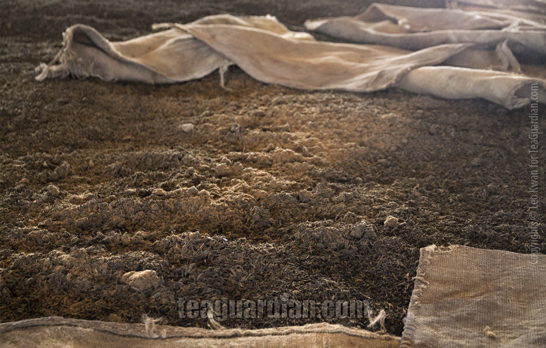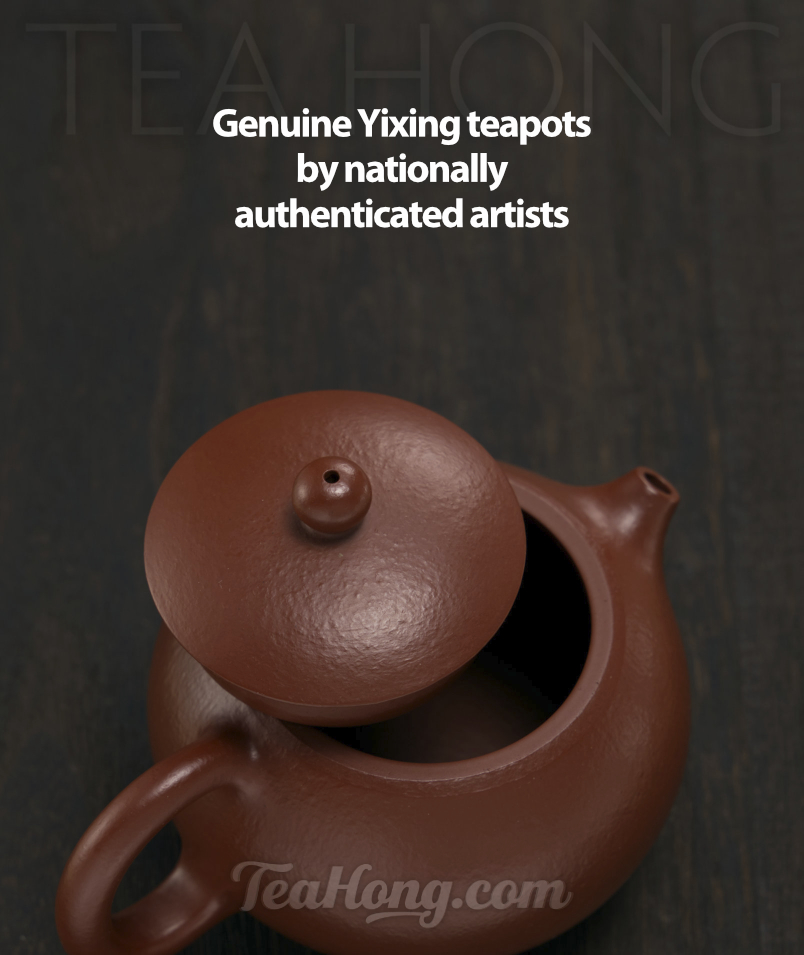“Raw” Puer or “Cooked” Puer?

Microbe growth during piled post fermentation in pu’er tea production. Menghai, Yunnan. One reason for the modern post-fermentation process to take three months is to let the microbes complete their life cycle naturally before halting it and drying the leaves. It is not advisable to let such microbes grow again in an uncontrolled condition or before you drink the tea, as in the myth of the so-called gold flower described below.
shu cha puer also needs to be matured
A shu cha improves with age. While it generally takes 10 years or more for a loose leaf shengcha, and 20 or more for a compressed one to taste smooth, a three-years good storage already gives impressive change to a shu cha. The modern post-fermentation method was developed exactly for this purpose — to dramatically shorten the time needed to mature productions that are otherwise too astringent and bitter for enjoyment.
dim sum restaurant puer: a cheap shu cha

The original demand for shu cha puer: the need of the common people. Outdoor dimsum eatery for the mass, 1960, Hong Kong.
Shu cha is the same category of tea that is what you order when you say “puer” ( or pu-erh, as in so many Chinatown restaurants ) in the dim sum restaurant, although you know virtually all such restaurants serve up unbearably low quality versions most of which taste so horrible that one would rather drink unpleasant plain hot water from their calcified water heating tanks. Nevertheless, a shu cha puer is a lot more suitable to be consumed with food and brewed to various strength, much better than a low quality shengcha. That was why tea vendors in old Hong Kong developed the post-fermentation process in the first place.
quality: priority number 1
However, one has to be aware that quality of production management is a major issue in producing shu cha. Post-fermentation involves a 3-month duration of fungus growth on the tealeaves. Lack of environmental control and the pile can easily become a hot bed for OTHER non-invited microbes or other small living things. In the China that is today, where many people’s morality can be cheaply traded for higher margins, malpractice is common place. One really have to watch out for tealeaves not properly fermented. That is why I never drink the puer served in dim sum restaurants, where normally tealeaves with the lowest cost are used. If you want to have puer tea while enjoying dimsum, bring your own tealeaves. This is an accepted practice, as long as you accept the restaurant’s “tea charges”.
A properly fermented and dried shu cha should smell the aroma of various wood, a touch of earth, with accents of hay, herbs, mushrooms, or even dried fruits. A properly matured one smell LESS than a newer one. Mouldy, ammonia, dusty smells etc are signs of malpractices in fermentation or storage. Avoid such selections.
The Myth of Gold flower
There has also been popular myth particularly in the Mainland Chinese market: that when certain “gold flowers” or “silver flowers” appear in a puer, or any other dark tea for that matter, that it tells of a high quality tea or one that has been well-matured. I have yet to hear any more nonsensical tall tales than this. These “flowers” are common moulds. Aspergillus, Acremonium, and Cladosporium can all appear orange-like against a dark colour tea background, depending on which strand of such common moulds.
Popularly, the shopkeeper will demand a higher price for such mouldy tea basing on the myth. That is China today. Don’t laugh at it. People, not just Mainlander Chinese who are more easily brain-washable because of the society they live in, but also those well educated ones outside of the border buy this. Human mind is a funny thing.
- Mengku Shengcha Pu’er 勐庫生茶普洱, aged dark tea
- Wild tea maocha 野生毛茶, Laos, a white tea by nature and is collected by the Chinese as an ingredient for shengcha pu’er. Produced in a process close to the white tea process, this is also a lightly oxidized tea like white tea is. Produced from a cultivar of the assamica variety and is entirely different from the Dabai group.
- A shengcha puer tea from the famous origin Bulang Shan in Xishuangbana in southern Yunnan
- Yiwu Daye, Semi-shengcha Pu’er 易武大葉半生茶普洱
- Special Grade Matured Pu’er, 特級陳年普洱 post-fermented tea. This is a fine leaf variety with golden tips
- Imperial Golden Tip Pu’er, aka Golden Tip Pu’er, or Gong-ting Pu’er 宮廷普洱 is a tippy fine leaf post-fermented dark tea. This one from 1997.
- Daye Pu’er, baked 焙火大葉普洱
- Yiwu Daye, Matured Shengcha Pu’er 陳年易武大葉生茶普洱
“shu” or “sheng”? choosing a tea for yourself
To compare the taste between shu cha and shengcha puer, generally a shu one is rounder, sweeter and softer, but shorter and lower on the high note. A quality shengcha properly matured, and thereby “ripened” ( i.e. to have “naturally” post-fermented ), can be sweet and dark as a shu cha, but with more pitch and depth, i.e. a broader taste gamut. However, such quality needs some search, and comes by with a few times the price.
A fresher shengcha is a different tea altogether. Expect a sharper tea. A really good one, however, can be floral or even bouquet, with a sweet, full body that is nevertheless bitter. The amount of bitterness is dependent on the harvest, processing and most importantly the make-up of the different cultivars that the tea is harvested from. Some say it is the sub-region, i.e. which “mountain”.
Whether shengcha or shu cha, however, we encourage the use of loose tea rather than compressed ones, unless there is certain strong preference. We notice that there is sales of broken up compressed teas in the market. This is an old practice when teashops want to get rid of over-stock products and those that are set at the wrong price. This is understandable because of the recent fluctuation in the wholesale market. However, attention is much needed in the hygiene of the breaking up and over-handling.
Lastly, health and TCM nature
A shu cha or a well matured shengcha is relatively neutral in TCM nature and therefore suitable for most people. They are also more versatile in food pairing and in any casual drinking.
On the other hand, a fresher shengcha is cold in TCM term and therefore a challenge to those with weaker stomachs or weaker yin energy. A person who is habitually under slept, over-worked, not-exercising, obese, low in libido, or having bowel issues are mostly weak in yin. Use this tea from this category with constrain.
However, fresher shengchas are very effective as a digestive, or moving the bowel ( when in moderate concentration ) and as a perk in the sleepy afternoon.



















hello, and thank you for the great articles. I would like to enquire about the tea bricks that were traditionally sold to Tibet, as i am a little confused as to the exact name of the tea. Also, someone told me that a double fermentation process was introduced in modern times in order to emulate the old flavour at the end of the caravans….whereby bricks that had absorbed the sweat of the porters or animals, and the fumes of campfires, were dried again….. is it true? what is the name of this tea? could it have been sold in bricks to tibet, in the 1990s? were the tea bricks from china the origin for the indian chai? any help would be appreciated, i am writing a book about tibet in 1995, and i would hate to get this detail wrong. Thank you!
Hello Simonetta,
I am glad you have enjoyed reading from our site. Here are two articles that will be very useful for your understanding of the topic:
https://teaguardian.mystagingwebsite.com/what-is-tea/post-fermented-tea-demystification/
https://teaguardian.mystagingwebsite.com/what-is-tea/compressed-teas/
As you will find out, “double-fermentation” actually refers to post-fermentation, and the proper name for Tibet brick tea is Zhang Cha.
These two other articles can be of use:
https://teaguardian.mystagingwebsite.com/what-is-tea/post-fermented-teas-aka-dark-teas/
https://teaguardian.mystagingwebsite.com/tea-health/fluorides-good-bad/
Zhang Cha has been a grocery item in Tibet since early days in history and most certainly before 1990. The fluoride poisoning incidents in that era in Tibet prompted improved standard for the product, which can be read about in the fluoride article above.
I hope this answers your question, but please let us know if you want to know more
so very thankful for your help!
fluoride is not mentioned in your articles, though….. and in your reply you refer to some poisoning incident in tibet around the years 1990s…. would you perhaps have some more info about that? thank you again, your help is much appreciated
Hello Simonetta, As mentioned in the previous reply, an article in one of the links deals with the topic about fluorides and the fluoride poisoning in Tibet in the 1990s was mentioned in the article:
https://teaguardian.mystagingwebsite.com/tea-health/fluorides-good-bad/